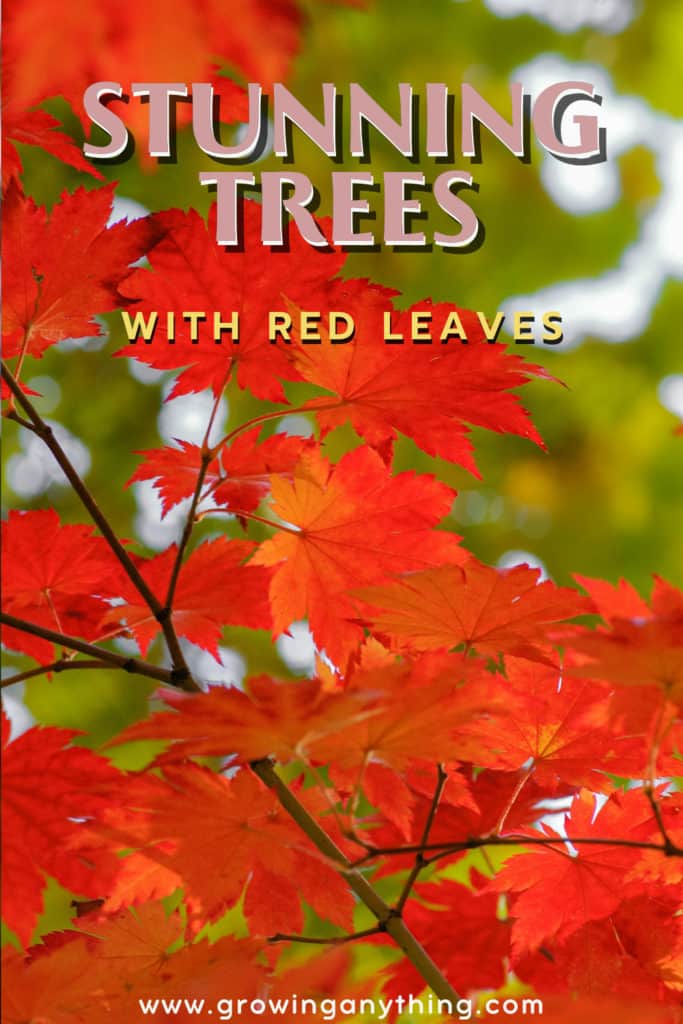22 Best Trees with Red Leaves
Trees with red leaves give a marvelous vibe in all gardens, near the road, in the backyard. Some trees keep their red leaves year-round, while others get the red fusion of color in the late summer and fall.
Whichever tree from my list you choose, red leaves will instantly create a picturesque effect in your backyard!
The red color in the leaves is due to anthocyanin, a special pigment made by sugar in the leaves. A certain number of plants contain the pigment year-round, while others have in fall.
Here is the list of the most charming trees with red leaves in the fall and year-round!
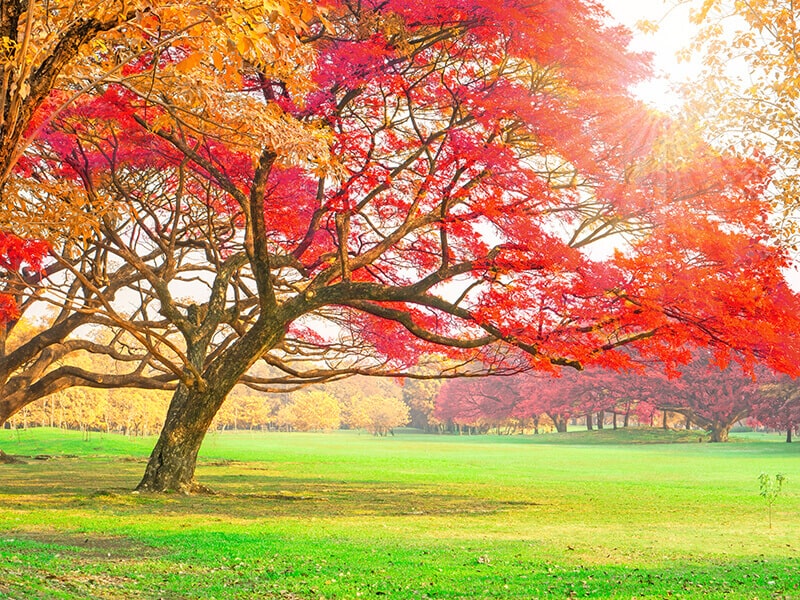
#1 Red Maple
Red Maple, Acer rubrum, Swamp, or Soft Maple is probably the most recognizable tree in central and eastern parts of North America. The tree features vibrant red leaves year-round!
The tree is fast-grower and perfect for zones 3-9. It can reach a maximum of 60 feet and spread around 40 feet when mature.
The tree is easy to grow, as it does well in most of the soil types. It does prefer wet soil, but a slight drought won’t do much damage.
Discover more about the Red Maple tree.
Find out the best way to plant a Maple tree. Watch the video below:
#2 Copper Beech
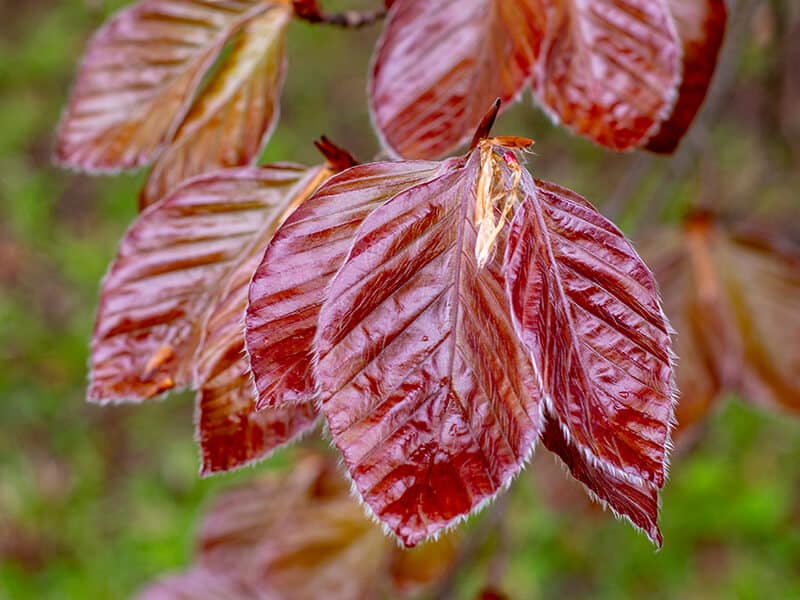
Fagus Sylvatica or Copper Beech is often called European Beech. The tree is large and deciduous with an upright oval crown. Surprisingly, the tree usually gets taller than 60 feet in America, while in Europe, you may see a tree 100 feet tall.
The Copper Beech is easily recognizable by its stunning copper-red leaves. In the spring, the tree develops yellow-green flowers, and ripe beechnuts are edible! You can find various cultivars in nurseries with slight variations in colors and shapes of leaves. Still, the cultivars with reddish foliage are the most popular!
Find out more about the origin of the Copper Beech!
#3 Shindeshojo Japanese Maple
Acer palmatum Shindeshojo, Japanese Maple, or Spring Ruby Tree is a colorful small tree with a high ornamental value year-round. In the spring, the tree develops pink foliage that slowly turns green and red in the summer. During the fall, Japanese Maple gets spectacular foliage in orange, bronze, and red colors.
The tree is short and bushy. You can also grow it in containers.
The ideal conditions are sunny or partial shade locations, protected from harsh winds!
Here is all the primary information on Japanese Maple to know before you plant it!
#4 Redbud Forest Pansy
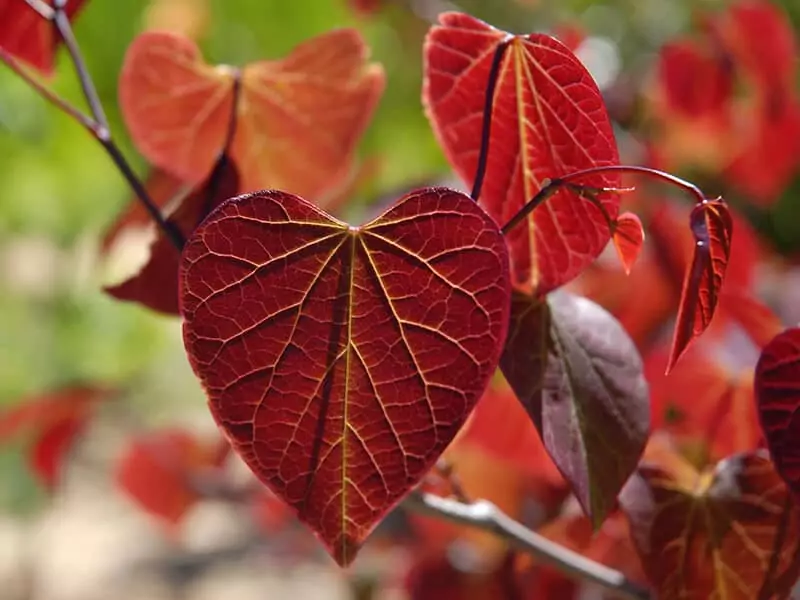
Redbud, the variety Cercis canadensis Forest Pansy, is popular for its attractive foliage. This small ornamental tree has heart-shaped foliage in vibrant red with a glossy finish. In the summer, the leaves turn dark purple, almost plum, just before the crown transforms to the orange-red and yellow blend of color!
On a sunny day in the autumn, the leaves look almost translucent! The light show on the tree makes the Forest Pansy very attractive and one of the most popular Redbud trees.
This multi-stemmed tree usually reaches less than 30 feet. But if given the right conditions, it can get very tall.
Do you want to know more about Redbud varieties? Click here to find out!
#5 Sugar Maple
Acer saccharum or Sugar Maple is similar to the Red Maple. But, Sugar Maple has broader leaves, which give the plant a fuller look. The leaf margins also differ because sugar maple leaves are smooth, unlike the edges of Red Maple leaves.
Also, Sugar Maple grows slower than the Red one. Both have stunning vivid red foliage and an oval-shaped crown.
Both trees are beautiful, so it is a matter of personal preference which one to grow.
When mature, the tree is between 60 and 75 tall and 40,50 feet wide.
Find out more differences between Red Maple and Sugar Maple.
#6 Smokebush
Cotinus coggygria, a Smoke tree or Smokebush is a lovely tree from the family of poisonous ivy. Smokebush is used as an accent plant in most cases. But, some people with a large garden like to plant these trees in a row to create a vivid hedge.
Smokebush is famous for its foliage color.
The leaves are bright red and orange in the fall. Some cultivars feature bright yellow leaves as well.
The tree is resilient to most pests and diseases, so it is a great tree for gardeners beginners.
Is Smokebush toxic? Find out before you plant it!
Learn the best way to prune your Smokebush. Watch this video below:
#7 American Sweetgum
Liquidambar styraciflua or American Sweetgum features a pyramidal and colorful crown. As the tree matures, the crown gets more of a rounded shape.
Sweetgum grows best in areas with little pollution. The tree is recognizable by its purple-red fall foliage. Surprisingly, the foliage stays on the tree for quite a while, decorating your garden.
The average height of Sweetgum is between 60 and 70 feet. An average spread is around 45 feet.
Read more about the Sweetgum tree!
#8 Royal Burgundy
Royal Burgundy is a statement plant in every garden. It isn’t too tall, and it reaches around 20 feet when mature. The tree features reddish to purple leaves and flowers.
The botanical name of the tree is Prunus Serrulata, and the tree prefers full sun exposure. The tree isn’t picky about the soil type. It will grow well in any soil, as long as it is well-draining. The exceptions are chalky and shallow locations.
Because of the year-round interest, beautiful foliage, and pink, double flowers, the Royal Burgundy tree is one of the highly awarded trees in the USA.
Here are more tips on how to grow a Royal Burgundy tree.
#9 Northern Red Oak
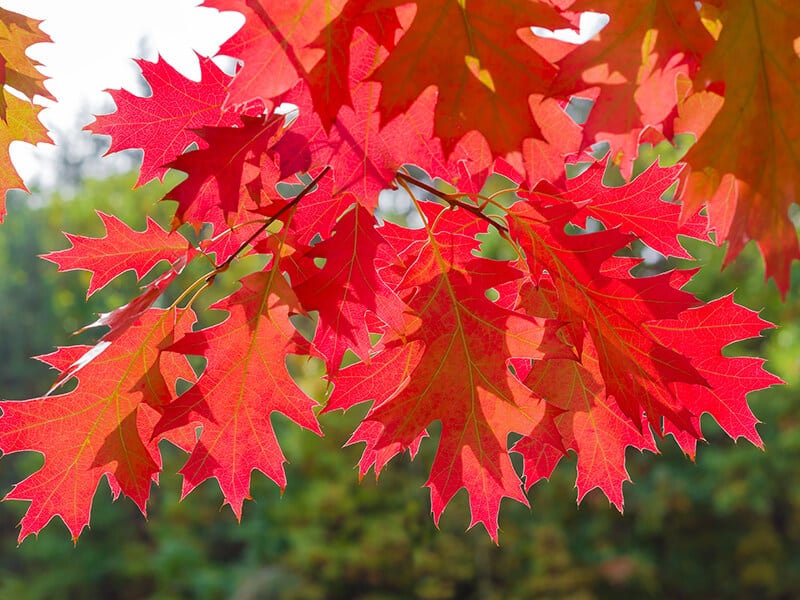
The sturdy and large Quercus rubra is known by its common name Northern Red Oak, or shortly Red Oak. The tree can reach 90 feet when mature!
Because Red Oak tolerates pollution well, it is a common choice for street trees in cities. It also does well in different soil types, as long as the planting site receives at least six hours of sunlight per day.
The primary season of interest for the Red Oak is fall when the crown gets orange and red. In the summer, the wide crown provides shade!
Find out about potential Oak disease to know how to identify it on time.
#10 Red Tip Photinia
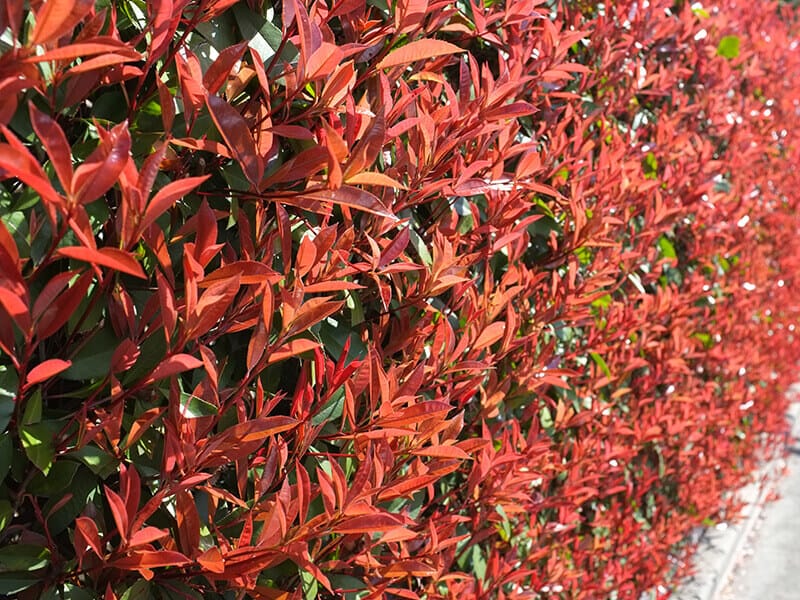
Photinia x fraseri or Red Tip Photinia develops young colorful leaves in the shades of red and bronze. The redbuds stay on the tree year-round and give the plant a stunning appearance.
Photinia grows well in different conditions, but it doesn’t do well in wet and humid locations. It is also prone to several pests and disease problems.
The average height of the mature plant is around 20 feet.
Discover how to use Red Tip Photinia for landscaping!
#11 Black Tupelo
Black Tupelo or botanically Nyssa sylvatica grows up to 80 feet and rarely exceeds that height. The tree features straight growing habit and dark flaky bark. As the tree matures, the bark becomes furrowed and structured.
The highlight of the tree is the foliage. The wide leaves are thick and hairy beneath. In the fall, leaves are scarlet red and shiny, a great addition to all landscapes.
The Black Tupelo tree is also famous as a wild honey source!
Do you want to know more about the beautiful Black Tupelo tree? Click here to find out!
#12 Sourwood
Sourwood grows between 20 and 30 feet in height. The botanical name of the tree is Oxydendrum arboreum.
The native habitat of the tree is in North Carolina, but you can find it all over the state. The alternate leaves are red and brown and transform to purple in fall.
Sourwood blooms in the summer. The flowers are heavily fragrant and stay on the tree for a full month. However, if you grow Sourwood in the shade, your tree will struggle to develop a flower. Nevertheless, the red and brown foliage is the main point of interest for this plant.
Find out more about the Sourwood tree!
#13 Sassafras
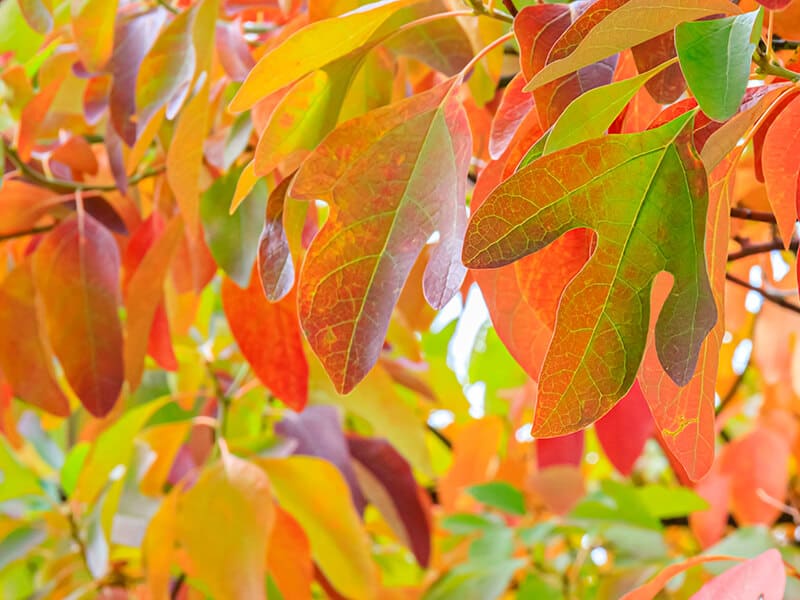
Sassafras albidum features horizontal branching and mahogany bark. Oval leaves are bright green with three lobs throughout the year. But, in the fall the leaves get orange and yellow red!
Interestingly, Sassafras’ bark and roots are the sources of some perfume soaps. Moreover, Sassafras tea is often used for root beer.
In the past, Sassafras was used for curing diseases, but nowadays, the tree is grown for ornamental value.
Find out more about the plant here.
#14 Pin Oak
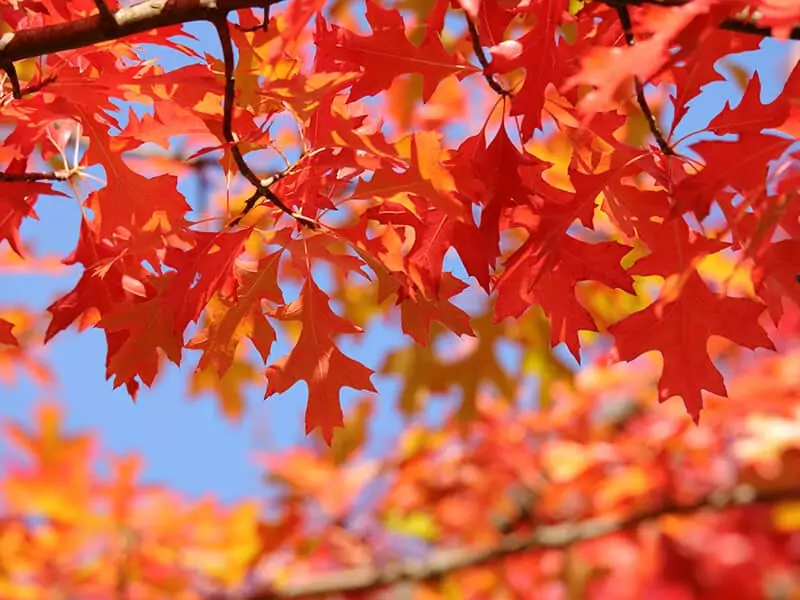
Quercus palustris is widely known as Pin Oak and is used for landscaping in various USDA zones. The tree is a fast grower, and may get over 24 inches in one year!
The average height of the tree is between 60 and 80 feet, with a spread of 30 feet. The key to growing the tallest Pin Oaks is the soil.
The ideal soil for this tree is acidic, moist, and rich soil. However, avoid planting Pin Oak on slopes because it won’t do well there.
In the summer, foliage is glossy green. But, when the temperature drops, the foliage turns red-bronze!
Learn how to use Pin Oak in the landscape!
#15 Red-Leaf Euphorbia
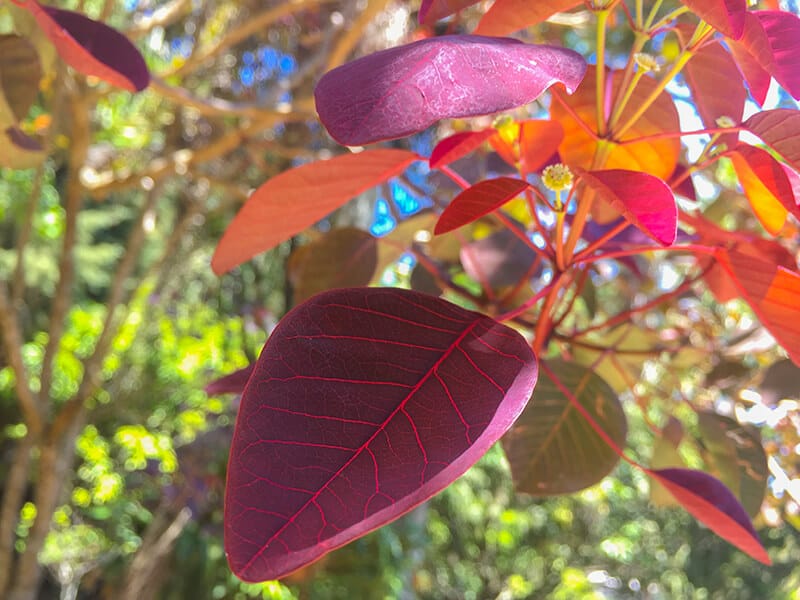
Euphorbia Cotinifolia or Red-Leaf Euphorbia is a fast-growing tree, ideal for the warm climate. It is excellent for landscaping because of the fast growth rate and ornamental foliage.
The plant can grow as a shrub and gets a maximum height of 15 feet. Other than red leaves, Euphorbia Cotinifolia is recognizable by interesting and delicate white flowers. In warm climates, the flowers can remain on the plant year-round!
Red-leaf Euphorbia is suitable for growing in containers in colder zones.
Discover more information on how to take care of Red-leaf Euphorbia!
#16 American Hornbeam
The small tree with a smooth and gray trunk called American Hornbeam grows up to 35 feet tall. The tree is also called Musclewood because of the muscle-like structure of the tree. The botanical name is Carpinus Caroliniana, and the tree is native to Missouri.
People love the American Hornbeam tree because of its large, oval colorful foliage in the fall. The most distinct are red leaves, but you’ll find the yellow and orange foliage as well.
The tree is easy to grow and very resistant to pests and diseases.
Is the American Hornbeam the right choice for you? Learn more about the tree and find out!
#17 Cranberry Hibiscus
Hibiscus acetosella or Cranberry Hibiscus is a woody, tree-like shrub plant. It features flashy foliage in the shades of burgundy red and purple.
Cranberry Hibiscus is a fast-grower with a short lifespan. Because of the fast-growing rate, the shrub still has high ornamental value for your garden. It is also beautiful during the blooming season when the plant develops large, funnel-shaped flowers.
Find out how to grow Hibiscus acetosella!
Discover if you can eat Hibiscus plant with this video:
#18 Chinese Fringe Flower
Loropetalum Chinese or Chinese Fringe Flower is a short plant, with the most common height of 15 feet. You can prune the plant to the desired size and train it to grow as a multi or single trunk plant. When grown as a single trunk plant, the Chinese Fringe Flower becomes an accent plant in the landscape.
Purple-red leaves are sometimes blended with similarly colored flowers! The plant is also used as a hedge and as a border plant.
When planting Loropetalum Chinese, pick well-draining soil to prevent root problems. Other than that, the Chinese Fringe Flower is relatively resistant to all pests and diseases.
Find the full guide on how to take care of Chinese Fringe Flowers!
#19 Winged Sumac
Rhus copallinum is also known as Winged or Shining Sumac. The shrub can grow like a tree and reach up to 35 feet. It features a crooked trunk and open branching pattern.
But, the most significant part of the Winged Sumac is the dark glossy leaves. In the fall, leaves transform into the reddish-purple and add a pop of color to every landscape.
The winded leaf axis is the primary feature that helps determine the Winged Sumac from other Sumac trees. This one is my favorite!
Read more about Rhus Copallinum!
#20 Flowering Dogwood Cornus Florida
Flowering Dogwood or Cornus Florida var rubra grows best in full sun sites but may tolerate partial shade. To increase the growth rate and grow a healthy plant, choose well-drained, acid soil with high organic matter content. When planting Dogwood, you may add a 2-inch layer of Mulch.
The red variety of the Flowering Dogwood develops red flowers in the spring and has dark red foliage in the fall. Moreover, the plant develops reddish fruits! It looks the best when planted near the building or around patios.
Learn more about red Flowering Dogwood!
Find out if you can plant a Dogwood tree as a potted plant. Watch the video:
#21 Cristina Ficus
Syzygium Campanulatum is the botanical name of the lovely tree commonly known as Cristina Ficus. The plant can be grown indoors in containers and outdoors as well!
It is a beautiful plant with dense foliage and a canopy shaped like a pyramid. When they first appear, the young leaves have a reddish-purple color!
Generally, Ficus Cristina is easy to grow. However, it is a slow-grower that doesn’t need fertilizer when planted in humus and loam soil.
Is Ficus Cristina for you? Read what nurseries have to say on this plant.
#22 Japanese Maple
Acer palmatum atropurpureum is a slow-growing cultivar of Japanese maple, similar to the cultivar Shindeshojo. However, the Atropurpureum variety features a cascading crown, which gives the tree a luscious appearance.
It is smaller than most Maple varieties and features distinct red leaves. The tree rarely grows over 20 feet and performs great in full sun and partial shade locations.
Find out how to provide the best care for your Acer palmatum atropurpureum!
Is The Fall The Prettiest Season? It Is With Red-Leaved Trees!
If you aren’t a big fan of sweater weather, you’ll become one when you start growing these trees with red leaves in your garden! Some of the trees keep their reddish and purple foliage for the entire year. Others may offer the spectacular display of red, orange, yellow, dark green, and purple shade in their crowing, providing the magical effect to every setting!
My favorite is the classy Red Maple, but I also like Pin Oak and Black Tupelo!
Which tree with red leaves seems like a great addition to your outdoor space? If you have grown any of the trees from my list, please share your experience!
